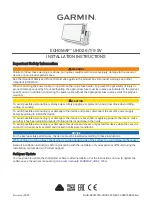
2.2 SIM-card installation and operation
The device supports using of one SIM-card. The SIM card (external) installation is carried out without the use of special
tools.
Figure 17. SIM-card installation to the device
Remove the SIM card holder from the device by pressing the yellow ejector button with a pen or a pencil. Place the SIM
card in the holder with the gold contacts facing out. Carefully insert the holder along with the SIM card back into the device.
Attention!
If the SIM-card is locked with a PIN code, it is necessary to unlock it by inserting the SIM card into a mobile phone or
specify the PIN-code of this card in the device settings in the “Data transmission” tab.
The balance of funds on SIM-cards should be sufficient for the device to operate on GPRS.
2.3 Power connection
The power supply of the system is carried out from the on-board network of the car, which should within the limits
indicated in Table 1, in the section
"Basic technical characteristics"
, or from the built-in rechargeable battery when the main
power is disconnected.
When voltage surges, which is more than the specified ratings, occur, the built-in overvoltage protection system will
operate in the device. It is strongly recommended to connect the device to the power supply through a 1 A fuse (not
included in standard equipment set). During installation the power supply should be connected the last turn when all the
other equipment is already connected. Connection of the power supply minus contact (GND) is carried out to the vehicle
“ground”.
Note:
On vehicles with disconnection of the “ground” in order to ensure uninterrupted operation, it is allowed to connect
the device power supply to the “+” and “-” circuits of the vehicle battery. In this case, it is not allowed to connect any
sensors, signal circuits or power supply circuits through which the device can be connected to the car body. Also, when the
car is powered by the battery in which the “ground” is disconnected, sensors cannot be connected to the device, the “-”
power supply of which is connected to the car body, without the use of galvanic isolation devices.
With an operation supply voltage and with the observance of the temperature mode of charging the built-in battery
(see the Table 1, in the section
"Basic technical characteristics"
), the built-in battery is constantly recharged through the
circuit of the device.
When the system operates only from the built-in battery, 1-Wire (IButton) do not function due to insufficient voltage.
Power supply from the built-in battery is sufficient for operation of universal inputs, RS-232 and RS-485 interfaces, built-in
accelerometer, GSM modem, GLONASS / GPS receiver and for the implementation of control outputs.
Summary of Contents for SMART S-2423
Page 11: ...Figure 13 Figure 14...











































